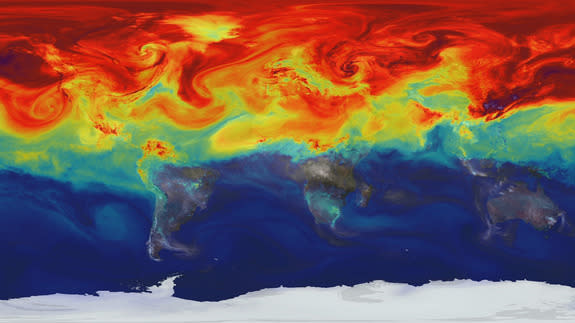Earth saw 'explosive' annual growth in carbon dioxide in 2015

Earth saw its largest annual spike in atmospheric carbon dioxide concentrations on record in 2015, according to new data released by the National Oceanic and Atmospheric Administration (NOAA).
The increase is significant because it demonstrates the continued march toward higher levels of global warming pollutants in the atmosphere. Those increasingly higher levels are helping to destabilize parts of Antarctica and Greenland, raise sea levels around the world, and cause more frequent and intense heat waves in many regions.
SEE ALSO: Sea level is now rising at fastest rate in nearly 3,000 years
It is a sobering milestone too, since countries are working more diligently than ever to cut emissions of planet-warming greenhouse gases, but the atmosphere is not yet seeing the results.
According to NOAA, carbon dioxide measurements taken at the Mauna Loa Observatory in Hawaii show that carbon dioxide concentrations jumped by 3.05 parts per million (ppm) during 2015, the largest year-to-year increase in 56 years of research.
Data stretching back at least 800,000 years shows that carbon dioxide levels are now higher than at any other time in human history.

Image: NOAA/Scripps
In another first, NOAA found that 2015 was the fourth straight year in which carbon dioxide concentrations grew by more than 2 ppm, according to Pieter Tans, who leads NOAA's Global Greenhouse Gas Reference Network.
“Carbon dioxide levels are increasing faster than they have in hundreds of thousands of years,” Tans said in a press release. “It’s explosive compared to natural processes.”
In February 2016, the average global atmospheric carbon dioxide level stood at 402.59 ppm. This is a dramatic increase from preindustrial times, when atmospheric carbon dioxide levels averaged about 280 ppm.
The world is currently on course to see carbon dioxide levels push past 450 to 500 parts per million by the end of the current century, unless emissions of greenhouse gases from burning fossil fuels are cut dramatically during the next two decades.
A single molecule of carbon dioxide can remain in the atmosphere for as long as 1,000 years, ensuring that global warming will continue for generations to come.
According to Tans, the current rate of increase in carbon dioxide levels is 200 times faster than the last time the planet saw such a sustained increase, which was between 17,000 and 11,000 years ago, when there was an 80 ppm increase during that timespan.

Image: NOAA/SCripps
The jump in carbon dioxide levels this year beat the old record, set in 1997-98. Both years featured strong El Niño events in the tropical Pacific, which tend to speed up the release of carbon dioxide as trees and other carbon-absorbing systems adjust to wild swings in weather patterns.
However, the long-term increase in carbon dioxide emissions is mainly due to the burning of fossil fuels such as coal, oil and natural gas.
The carbon dioxide concentration record contrasts with the recent trend in global annual emissions of greenhouse gases, which may have stalled or fallen slightly in 2015 compared to previous years. However, it would take a much more significant drop in emissions — all the way to zero or so-called "negative emissions," in which the Earth absorbs more carbon dioxide than people emit, in order to stabilize and then drag down atmospheric levels over time.


